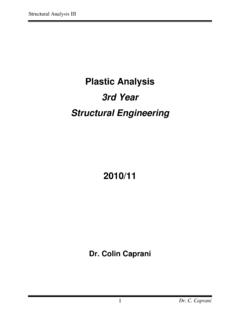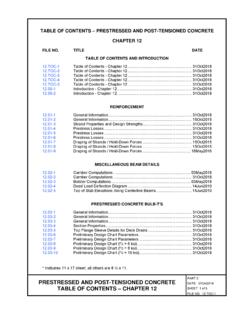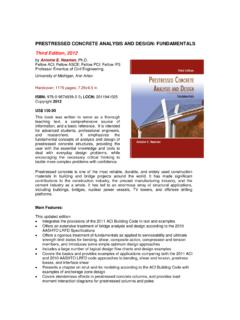Transcription of Prestressed Concrete - Colin Caprani
1 Civil Engineering Design (1) Dr. C. Caprani 1 Civil Engineering Design (1) Prestressed Concrete 2006/7 Dr. Colin Caprani , Chartered Engineer Civil Engineering Design (1) Dr. C. Caprani 2 Contents 1. Introduction .. 3 3 Basic Principle of Prestressing .. 4 Advantages of Prestressed Concrete .. 6 Materials .. 7 Methods of 10 Uses of Prestressed 15 2. Stresses in Prestressed Members .. 16 16 Basic Principle of Prestressed Concrete .. 19 3. Design of PSC Members .. 29 29 Minimum Section Modulus .. 32 Prestressing Force & Eccentricity .. 37 Eccentricity Limits and Tendon 49 4. Prestressing Losses.
2 56 Basis and Notation .. 56 Losses in Pre-Tensioned 57 Losses in Post-tensioned PSC .. 60 5. Ultimate Limit State Design of PSC .. 66 Ultimate Moment Capacity .. 66 Ultimate Shear 71 Civil Engineering Design (1) Dr. C. Caprani 31. Introduction Background The idea of Prestressed Concrete has been around since the latter decades of the 19th century, but its use was limited by the quality of the materials at the time. It took until the 1920s and 30s for its materials development to progress to a level where Prestressed Concrete could be used with confidence. Freyssinet in France, Magnel in Belgium and Hoyer in Germany were the principle developers.
3 The idea of prestressing has also been applied to many other forms, such as: Wagon wheels; Riveting; Barrels, the coopers trade; In these cases heated metal is made to just fit an object. When the metal cools it contracts inducing prestress into the object. Civil Engineering Design (1) Dr. C. Caprani Basic Principle of Prestressing Basic Example The classic everyday example of prestressing is this: a row of books can be lifted by squeezing the ends together: The structural explanation is that the row of books has zero tensile capacity. Therefore the beam of books cannot even carry its self weight.
4 To overcome this we provide an external initial stress (the prestress) which compresses the books together. Now they can only separate if the tensile stress induced by the self weight of the books is greater than the compressive prestress introduced. Concrete Concrete is very strong in compression but weak in tension. In an ordinary Concrete beam the tensile stress at the bottom: Civil Engineering Design (1) Dr. C. Caprani 5are taken by standard steel reinforcement: But we still get cracking, which is due to both bending and shear: In Prestressed Concrete , because the prestressing keeps the Concrete in compression, no cracking occurs.
5 This is often preferable where durability is a concern. Civil Engineering Design (1) Dr. C. Caprani Advantages of Prestressed Concrete The main advantages of Prestressed Concrete (PSC) are: Smaller Section Sizes Since PSC uses the whole Concrete section, the second moment of area is bigger and so the section is stiffer: Smaller Deflections The larger second moment of area greatly reduces deflections for a given section size. Increased Spans The smaller section size reduces self weight. Hence a given section can span further with Prestressed Concrete than it can with ordinary reinforced Concrete . Durability Since the entire section remains in compression, no cracking of the Concrete can occur and hence there is little penetration of the cover.
6 This greatly improves the long-term durability of structures, especially bridges and also means that Concrete tanks can be made as watertight as steel tanks, with far greater durability. AN A NRC PSC Civil Engineering Design (1) Dr. C. Caprani Materials Concrete The main factors for Concrete used in PSC are: Ordinary portland cement-based Concrete is used but strength usually greater than 50 N/mm2; A high early strength is required to enable quicker application of prestress; A larger elastic modulus is needed to reduce the shortening of the member; A mix that reduces creep of the Concrete to minimize losses of prestress; You can see the importance creep has in PSC from this graph: Civil Engineering Design (1) Dr.
7 C. Caprani 8 Steel The steel used for prestressing has a nominal yield strength of between 1550 to 1800 N/mm2. The different forms the steel may take are: Wires: individually drawn wires of 7 mm diameter; Strands: a collection of wires (usually 7) wound together and thus having a diameter that is different to its area; Tendon: A collection of strands encased in a duct only used in post-tensioning; Bar: a specially formed bar of high strength steel of greater than 20 mm diameter. Prestressed Concrete bridge beams typically use mm diameter (but with an area of 150 mm2)7-wire super strand which has a breaking load of 265 kN.
8 Civil Engineering Design (1) Dr. C. Caprani 9 Civil Engineering Design (1) Dr. C. Caprani Methods of Prestressing There are two methods of prestressing: Pre-tensioning: Apply prestress to steel strands before casting Concrete ; Post-tensioning: Apply prestress to steel tendons after casting Concrete . Pre-tensioning This is the most common form for precast sections. In Stage 1 the wires or strands are stressed; in Stage 2 the Concrete is cast around the stressed wires/strands; and in Stage 3 the Prestressed in transferred from the external anchorages to the Concrete , once it has sufficient strength: Civil Engineering Design (1) Dr.
9 C. Caprani 11In pre-tensioned members, the strand is directly bonded to the Concrete cast around it. Therefore, at the ends of the member, there is a transmission length where the strand force is transferred to the Concrete through the bond: At the ends of pre-tensioned members it is sometimes necessary to debond the strand from the Concrete . This is to keep the stresses within allowable limits where there is little stress induced by self with or other loads: Civil Engineering Design (1) Dr. C. Caprani 12 Post-tensioned In this method, the Concrete has already set but has ducts cast into it. The strands or tendons are fed through the ducts (Stage 1) then tensioned (Stage 2) and then anchored to the Concrete (Stage 3): The anchorages to post-tensioned members must distribute a large load to the Concrete , and must resist bursting forces as a result.
10 A lot of ordinary reinforcement is often necessary. A typical tendon anchorage is: Civil Engineering Design (1) Dr. C. Caprani 13 And the end of a post-tensioned member has reinforcement such as: Civil Engineering Design (1) Dr. C. Caprani 14 Losses From the time the prestress is applied, the prestress force gradually reduces over time to an equilibrium level. The sources of these losses depend on the method by which prestressing is applied. In both methods: The member shortens due to the force and this relieves some of the prestress; The Concrete shrinks as it further cures; The steel relaxes , that is, the steel stress reduces over time; The Concrete creeps, that is, continues to strain over time.














